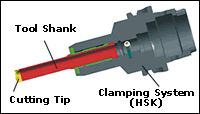 Machining magnesium parts is risky business. The small chips and fine dust generated during cutting are highly flammable and pose a serious fire risk if not properly handled. These particles are commonly removed from the machine tool by means of a vacuum extraction system, in some cases using a hood mounted near the cutting tool to collect particles as soon as they are produced. Dry machining or use of minimum quantity lubrication (MQL) in conjunction with this extraction method allow chips to be recycled and can eliminate secondary part cleaning operations. However, auxiliary collection devices hamper both tool changes and machine high speed movements.
Machining magnesium parts is risky business. The small chips and fine dust generated during cutting are highly flammable and pose a serious fire risk if not properly handled. These particles are commonly removed from the machine tool by means of a vacuum extraction system, in some cases using a hood mounted near the cutting tool to collect particles as soon as they are produced. Dry machining or use of minimum quantity lubrication (MQL) in conjunction with this extraction method allow chips to be recycled and can eliminate secondary part cleaning operations. However, auxiliary collection devices hamper both tool changes and machine high speed movements.
The use of oil-based coolants reduces, but doesn’t eliminate, the fire risk. In addition, the magnesium particles mixed in oil can’t be recycled, and the machined parts would require extensive cleaning to remove oil residue.
Spain’s IDEKO research institute, part of the Danobat Group, has recently concluded a multi-company R&D project that aimed to develop a safer method of high speed magnesium machining. The result is a novel system of extracting magnesium particles by vacuuming them through a hollow cutting tool and spindle, and into a collection container. Think in terms of through-spindle coolant delivery in reverse.
The key components in this system are cutting tool, tool holder and spindle. The tools have hollow shafts and carbide cutting tips with special geometries. A circular interpolating tool motion facilitates chip collection for the end mill tool version, as this yields smaller chips that are less likely to clog the flow through the system. Some tools also integrate a chip breaker to create even smaller, lighter chips. The system uses an HSK toolholder interface that is modified to prevent chip jams, and a through-coolant-type draw bar that is similarly tailored for optimal flow in reverse. (See online video above that shows an end mill pocket milling valve reliefs in the top of a piston.)
IDEKO determined that the system provides an average chip extraction rate of 95 percent for magnesium chips. Additional testing is being performed to verify system applicability for machining aluminum alloys. The key for use with non-magnesium materials is to generate chips that are small enough to be easily transported through the tool and the system’s other internal passages.
Monday, February 27, 2006
Developing A Safer Way To Machine Magnesium
Posted by
CNC-on-NET
at
4:51 AM
![]()
Subscribe to:
Post Comments (Atom)





No comments:
Post a Comment